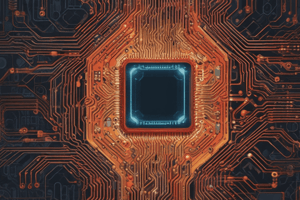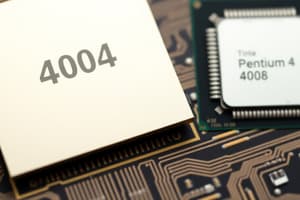Podcast
Questions and Answers
What is the job of a chipset on a motherboard?
What is the job of a chipset on a motherboard?
control data flow between the CPU, peripherals, bus slots, and memory
What is the main advantage of Harvard architecture compared to Von Neumann architecture?
What is the main advantage of Harvard architecture compared to Von Neumann architecture?
Separate buses for instruction and data allow the CPU to access instructions and read/write data simultaneously.
Which of the following types of buses are used in Harvard architecture? (Select all that apply)
Which of the following types of buses are used in Harvard architecture? (Select all that apply)
- Instruction Bus (correct)
- Instruction Address Bus (correct)
- Data Bus (correct)
- Data Address Bus (correct)
Which type of processors can perform 8-bit data operations at a time?
Which type of processors can perform 8-bit data operations at a time?
Harvard architecture has separate ______ for instruction and data.
Harvard architecture has separate ______ for instruction and data.
The Northbridge chipset is responsible for connecting the CPU to the memory and expansion slots.
The Northbridge chipset is responsible for connecting the CPU to the memory and expansion slots.
True or False: Harvard architecture uses two separate caches, one for data and one for instructions.
True or False: Harvard architecture uses two separate caches, one for data and one for instructions.
A bus is a pathway that allows data and signals to travel between ______________ on the motherboard.
A bus is a pathway that allows data and signals to travel between ______________ on the motherboard.
Match the following components of ISA (Instruction set architecture) computers:
Match the following components of ISA (Instruction set architecture) computers:
Flashcards are hidden until you start studying
Study Notes
Evolution of Microprocessors
- The evolution of microprocessors started with vacuum tubes (1939-1954), followed by transistors (1954-1959), and then transistors and IC (1959-1971).
- The fourth generation (1971-present) introduced microprocessors.
- A microprocessor is identified by its word size of data.
- The ALU (Arithmetic Logic Unit) can perform operations on data of a specific size (e.g., 4-bit, 8-bit, 16-bit, 32-bit, or 64-bit).
Types of Microprocessors
- 4-Bit Processors: Intel 4004, Intel 4040
- 8-Bit Processors: 8008, 8080, 8085, Motorola 6800 (M6800)
- 16-Bit Processors: 8086, 8088, Zilog 2800, 80186, 80286
- 32-Bit Processors: Intel 80386, 80387, 80486, Intel Pentium, Intel Pentium Pro, Intel Pentium II, Intel Pentium III, Intel Pentium IV, Intel Dual Core
- 64-Bit Processors: Intel Core 2, Intel Core I7, Intel Core I5, Intel Core I3
Chipset
- A chipset is a set of chips that replaces multiple chips on the motherboard, controlling data flow between the CPU, peripherals, bus slots, and memory.
- It consists of two main components: Northbridge and Southbridge.
- Northbridge is located near the CPU, connecting it to the memory, AGP, and PCI-Express slots.
- Southbridge is located near the PCI bus slots, connecting to the PCI bus, SATA, IDE, and USB ports.
Bus
- A bus is a pathway or set of pathways that allows data and signals to travel between components on the motherboard.
- Bus speed refers to the speed at which data can be sent (e.g., 66 MHz).
- Faster bus speeds enable computers to perform tasks more quickly.
Expansion Slots
- PCIe (Peripheral Component Interconnect Express) is an interface standard for connecting high-speed I/O components (e.g., GPUs, RAID cards, Wi-Fi cards, SSD add-on cards).
- SATA (Serial Advanced Technology Attachment) is an industry-standard bus interface for connecting storage devices (e.g., hard disk drives, solid-state drives).
- AGP (Accelerated Graphics Port) is a point-to-point channel for connecting graphic cards to the motherboard, increasing graphics rendering speed.
Computer Organization
- There are two types of computers: Fixed Program Computers and Stored Program Computers.
- Stored Program Computers, introduced by John von Neumann, store programs and data in a separate storage unit called memory.
- Von Neumann Architecture consists of a processing unit, control unit, memory, external mass storage, and input/output mechanisms.
ISA (Instruction Set Architecture)
- ISA components include:
- Control Unit: handles processor control signals and directs input/output flow.
- Arithmetic Logic Unit (ALU): performs calculations and logical operations.
- Registers: high-speed storage areas in the CPU, including Accumulator, Program Counter, Memory Address Register, Memory Data Register, Current Instruction Register, and Instruction Buffer Register.
- Buses: Data Bus, Address Bus, and Control Bus.
Harvard Architecture
- Harvard Architecture is an alternative to Von Neumann Architecture, separating storage and buses for instructions and data.
- It allows the CPU to access instructions and read/write data simultaneously.
- Harvard Architecture is used in modified form in X86 and ARM processors.
Studying That Suits You
Use AI to generate personalized quizzes and flashcards to suit your learning preferences.




